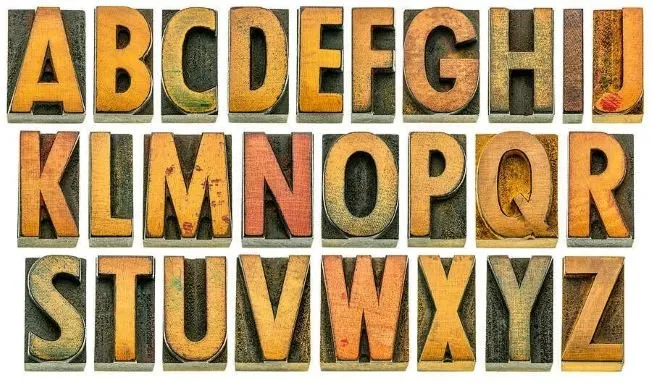
The Origin of the English Alphabet Revealed by the Smallest Elements
Understanding the origin of the English alphabet is essential as it allows you to understand how many letters are in the English alphabet and why it is so.

On July 4, American citizens celebrate Independence Day. On this date, the country honors passing the Declaration of Independence that proclaimed America a free nation. This document came into existence after the long struggle of the Revolutionary War, and until now, the Declaration states the principles of government and people’s identity as Americans. This famous document first stated that all men are created equal and have inalienable rights for life, liberty, and pursuit of happiness. These words are sacred for every US citizen. Historically, this document inspired many nations and was translated into many languages. In the course of translation, there were various cases when it resulted in tiny errors. In our article, we reveal interesting facts about the Declaration of Independence.
German translation of the Declaration of Independence was striking due to many facts. A German printer Heinrich Miller printed the version just four days after the Declaration was passed. It turns out that people in Germany were fascinated by events in America and admired their struggle. German citizens wanted to embody more modern ideas of equality and natural rights in their land, that’s why the document was well-received (Powell, 2016). When it comes to translation, the German version was a matter of word choice. Although the meaning of the document was right, some phrases sounded differently. For example, the phrase “people are created equal… with certain unalienable rights” became “people of their own who are equal to other powers because of the laws of nature” (Adams, 2006). This sounds rather unclear, but for German people, it made sense because the language choices were close to them. Another misinterpreted phrase was “self-evident truths,” which turned “truths accepted by everyone” (Adams, 2006). There is a similarity in the meaning of those phrases, although they are rather far from each other. The translator of the Declaration tried to say the same using German words that the target audience will understand. It may sound rather unusual to us, but the point is, German people got the message right.
The Spanish translation of the Declaration had a long and saturated history. It wasn’t released for almost nine decades. However, for Spanish people, it had revolutionary significance and changed their lives greatly. Spain had its Glorious Revolution partly because of the Declaration (Powell, 2016). However, it was translated rather seldom. Why? The answer is interesting. It turns out that Spanish people were avid Catholics who thought that happiness can exist only in the other world. However, Jefferson stated in the Declaration that people can pursue happiness throughout their lives. That’s why people in Spain just could not understand what he is talking about, as the idea was brand new to them. Another novel idea was “self-government,” so Spanish translators simply did not change it! (Oltra, 1999). Also, Spanish translators did not like the sound of some of Jefferson’s phrases, namely “Nature’s God,” because for Catholics, God was a holy person. So, the translators changed these words into poetic “Divine Nature” (Oltra, 199) Today, such translation is called localization, or, in other words, a re-creation of the original message for the native audience.
The pathways of the Japanese translation of the Declaration were complicated and tangled. It was not directly translated from English, because Japanese people got it from a history book in Chinese. There were reasons to do so. It's hard to believe, but once, there weren't any good Japanese-English dictionaries! (Powell, 2016). Japan was long in isolation and they just did not need it. Later, there were attempts to translate from the original document, but it was a very hard task. The concepts of rights, freedom, and equality did not even have corresponding words in Japanese, so people had to invent new terminology. Sure, Japanese politics and culture were different from Western ones. This resulted in an unusual translation of certain words. This way, “unalienable rights” became “unremovable rights,” and “liberty” turned into “license” (Eoyang, 1999). The phrase “pursuit of happiness” also was reinvented in Japanese (Eoyang, 1999). It turned into “the wish to enjoy happiness,” because the Japanese were mainly Buddhists who believed that physical happiness means nothing. They did not need personal happiness through jobs, material goods, and life dreams. Buddhist teachings say to live in the moment and not pursue future goals. Of course, translation was adjusted to these beliefs.
In Russia, the people did not access the Declaration due to political reasons. It wasn’t released for eight decades, because czars and empresses in Russia did not want the folk to read it (Powell, 2016). They thought it could provoke revolutionary thought and, of course, banished it for a very long time. Even after the revolution in Russia, it was not very popular. It was published in the Soviet Union, but as the US and USSR competed with each other and had different ideologies, the Declaration wasn’t welcomed. Law professionals studied it along with other documents from “bourgeois” countries (Vlasova, 1999). Such states were a "threat" to Communism, so people feared to spread the Declaration's ideas. The Russian translation was rather interesting, for example, there was a call “to throw off such Government, and to provide new Guards for their future security” (Vlasova, 1999). For Russian people, the free government turned into a system where a ruler safeguards their people. In totalitarian Soviet Russia, translating democratic ideas was a dangerous thing, so the translators made some changes to make it pass censorship.
We know France as a revolutionary country whose folk were brave to stand up for their rights during the French Revolution. However, at the time of the Declaration, it was prohibited to distribute, and it is still unknown who exactly did a translation of this document. There is a historical explanation for this. Until a certain moment, the French government did not support American rebels (Powell, 2016). Still, the folk in France were extremely interested in this document, and later, it was one of the factors that led to the French Revolution. So, the US Declaration of Independence indirectly caused the revolution in France. When it came to translation, French people correctly rendered the idea of natural rights. However, in the final version, it sounded different. Try to guess the phrase: “The new men enjoy their primitive sovereignty… in the bosom of nature” (Marienstras & Wulf, 1999). This is how the statement about natural rights sounds in French. The rest of the translation was close to the original. Still, the French did not like “nationalistic” tone, and changed it into a more universal one, for example, used “mankind” instead of “men” in some translations (Marienstras & Wulf, 1999).
When the Declaration was translated to China, the people there did not understand what natural rights were. It may be shocking to us, but at that time, Chinese people had no idea about civil rights, and there wasn’t even such a word as “freedom” (Eoyang, 1999). So, the translators had a hard time explaining it to readers. Moreover, because of Buddhism, people in China believed that God is an ultimate deity that rules in heaven and supervises people on earth. Thus, “unalienable rights which are given by God” were translated as “the nature… of the physical world and that of the way of heaven” (Eoyang, 1999). So, God wasn’t directly mentioned in the Chinese version of the Declaration. Surely, the spiritual nature of Chinese beliefs influenced their understanding of the Constitution.
Without a doubt, the Declaration of Independence is a guidebook of life and freedom for all Americans. It had a massive influence on people worldwide and was translated into many languages. Both Independence Day and the Declaration are dear to our hearts. TheWordPoint congratulates you with this holiday which signifies the birth of a nation. On this day, we wish you to always have the freedom to live happily, freedom to dream, and freedom to choose. Happy Independence Day 2020!
1. Adams, W. P. (1999). German translations of the American Declaration of Independence. Retrieved 2020, from http://chnm.gmu.edu/declaration/adams2
2. Eoyang, E. (1999). Life, liberty, and the pursuit of linguistic parity: Multilingual Perspectives on the Declaration of Independence. Retrieved 2020, from http://chnm.gmu.edu/declaration/eoyang.html
3. Oltra, J. (2006). Jefferson’s Declaration of Independence in the Spanish Political Tradition. Retrieved 2020, from http://chnm.gmu.edu/declaration/oltra.html
4. Powell, J. (2016). How people abroad viewed our Declaration of Independence. Retrieved 2020, from https://www.cato.org/blog/how-people-abroad-viewed-our-declaration-independence
5. Marienstras, E., and Wulf, N. (1999). French translations and reception of the Declaration of Independence. Retrieved 2020, from http://chnm.gmu.edu/declaration/marien.html
6. Vlasova, M. A. (1999). The American Declaration of Independence in Russian: The history of translation and the translation of history. Retrieved 2020, from http://chnm.gmu.edu/declaration/vlasova.html

Understanding the origin of the English alphabet is essential as it allows you to understand how many letters are in the English alphabet and why it is so.

If you want to learn how to say I love you in different languages, that’s a pretty easy task. So is learning how to say I love you back. These are common phrases in Romantic and Germanic languages, and the sentiment is common enough that it’s easy to find an interpretation of the term in other language families.

Who remains the world's most translated author, why this happened. Learn interesting facts about writer's life and achievements.
Your personal account was created successfully. Login details were sent to your email.
Thank you for choosing our service!
You have registered your account successfully!
Your application was sent to our
HR Departament.
Get prepared to pass several proficiency tests to prove your skills as we hire only the best experts to deliver the best quality to our Clients. We will contact you soon for futher instructions